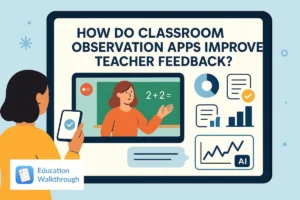Provide Teachers Instant Feedback
What is Data Driven Instruction?
Data-driven instruction is a teaching approach that uses data to inform instructional decisions and guide teaching strategies. By analyzing data from assessments, classroom activities, and student performance, teachers can make informed adjustments to their lessons and curriculum, ensuring that every student’s needs are met. This method allows teachers to focus on areas where students are struggling and tailor their instruction for maximum impact.
Data-driven instruction has become an essential strategy for schools striving to improve student achievement. Instead of relying solely on intuition or traditional methods, educators use concrete evidence to support their teaching decisions, ensuring that interventions are targeted and effective.
Why is Data-Driven Instruction Important?
Data-driven instruction enables teachers to:
- Personalize Learning: By identifying individual student strengths and weaknesses through data, teachers can offer personalized instruction that addresses specific learning gaps.
- Improve Student Outcomes: When instruction is tailored to meet student needs based on data, student performance improves, leading to higher test scores, better engagement, and deeper understanding.
- Make Informed Decisions: Teachers no longer need to guess which strategies work best. Data offers concrete insights into what’s effective, allowing educators to focus on proven methods.
- Adapt and Respond in Real Time: Teachers can adjust their teaching methods in real-time based on student performance data, ensuring that no student is left behind.
Data-driven instruction creates a clear link between teaching practices and student outcomes, making it easier to track progress and ensure continuous improvement.
Examples of Data-Driven Instruction in the Classroom
Data-driven instruction can be applied in various ways in the classroom, from daily lessons to long-term curriculum planning. Below are some practical examples:
Using Formative Assessments to Guide Daily Instruction
Teachers can administer quick, formative assessments such as exit tickets or quizzes to check for understanding after a lesson. The results are analyzed to determine whether students have grasped the material or if re-teaching is necessary. This immediate feedback allows teachers to make instructional changes on the fly.
Grouping Students by Ability Levels
Based on assessment data, teachers can group students by their skill levels. For instance, students who need more support can work in small groups or receive one-on-one instruction, while advanced students can be given more challenging tasks. This ensures all students get the instruction they need at their current learning level.
Tracking Progress Over Time
Teachers can use data from standardized tests and formative assessments to monitor student progress throughout the year. By analyzing trends, educators can identify which students are improving and which need additional support, making data-driven decisions to adjust curriculum pacing or introduce interventions.
Setting Student-Specific Learning Goals
Data allows teachers to set individualized learning goals for students. These goals are specific, measurable, and tailored to each student’s unique needs. Progress toward these goals is tracked through ongoing data collection, and instruction is adjusted accordingly.
Steps for Implementing Data-Driven Instruction
Effective implementation of data-driven instruction involves several key steps that teachers and administrators must follow to ensure success:
1. Collect High-Quality Data
The foundation of data-driven instruction is the data itself. Teachers need access to high-quality, accurate data to inform their instructional decisions. This data can come from:
- Formative assessments (quizzes, exit tickets)
- Summative assessments (end-of-unit or state tests)
- Student work samples
- Behavioral and engagement data
It’s crucial that the data is reliable, timely, and easy to interpret. Schools should invest in robust data systems that collect, analyze, and present data in a way that is useful for teachers.
2. Analyze the Data
Once data is collected, it must be carefully analyzed to identify patterns and trends. Teachers should look for areas where students are excelling and where they are struggling. This analysis provides valuable insights into the effectiveness of teaching strategies and reveals areas where instruction needs to be adjusted.
For example, if data shows that a significant portion of the class is struggling with fractions, the teacher can devote extra time to re-teaching this concept or use different instructional methods.
3. Develop an Action Plan
After analyzing the data, teachers should create an action plan that outlines how they will address the identified issues. This plan should include:
- Specific instructional adjustments
- Targeted interventions for struggling students
- Goals for student achievement
- A timeline for implementing these changes
The action plan should be flexible, allowing for ongoing adjustments as more data is collected.
4. Implement the Action Plan
With a plan in place, it’s time to implement it. Teachers should adjust their lessons, introduce interventions, and provide differentiated instruction based on the data. It’s important to stay consistent in implementing the action plan, but also be willing to make modifications as new data becomes available.
5. Monitor Progress and Adjust
Data-driven instruction is an ongoing process. Teachers should continually collect data to monitor progress toward the goals set in the action plan. As they track student progress, teachers can adjust their instruction to ensure students are staying on track.
This cycle of collecting data, analyzing it, and adjusting instruction helps create a dynamic learning environment where student needs are consistently addressed.
The Benefits of Data-Driven Instruction
Implementing data-driven instruction brings several key benefits:
- Targeted Instruction: Teachers can focus on specific areas where students need improvement, rather than adopting a one-size-fits-all approach.
- Increased Accountability: Data provides transparency and accountability for teachers, as it clearly shows the impact of their instructional decisions on student performance.
- Engaged Learning: When instruction is tailored to student needs, learners are more engaged and motivated to succeed. They feel supported, as teachers address their specific challenges and strengths.
- Improved Student Achievement: Research shows that students in data-driven classrooms perform better on assessments, as the instruction is more relevant and effective.
Overcoming Challenges in Data-Driven Instruction
While data-driven instruction offers numerous benefits, it also presents certain challenges:
- Access to Reliable Data: Schools need robust systems for collecting and analyzing data. Without accurate, reliable data, it’s impossible to make informed instructional decisions.
- Teacher Training: Not all teachers are trained in data analysis, and interpreting data can be overwhelming. Ongoing professional development is essential to ensure that teachers can confidently use data to guide instruction.
- Time Constraints: Teachers already face significant time pressures, and the added task of data analysis can be daunting. Schools should provide support to help teachers manage the workload involved in data-driven instruction.
By addressing these challenges, schools can ensure that data-driven instruction is implemented effectively and that both teachers and students benefit from this approach.
How Education Walkthrough Can Support Data-Driven Instruction
Implementing data-driven instruction effectively requires the right tools to collect, analyze, and act on data. This is where Education Walkthrough comes in.
Education Walkthrough offers a powerful platform that helps school leaders and teachers conduct classroom walkthroughs and gather data on teaching practices in real time. This data can be used to:
- Identify instructional gaps: Classroom observations can reveal specific areas where instruction could be improved or where students may need additional support.
- Provide instant feedback: With Education Walkthrough, administrators can offer teachers immediate, data-backed feedback that helps them adjust their teaching strategies for better outcomes.
- Monitor progress: The platform makes it easy to track instructional changes over time and assess their impact on student performance.
Using Education Walkthrough, schools can streamline the process of data collection and analysis, making it easier to implement data-driven instruction and improve student outcomes.
The Future of Data Driven Instruction
Data-driven instruction is a powerful tool for improving student outcomes, but it requires careful planning, reliable data, and ongoing adjustments. By collecting high-quality data, analyzing it effectively, and using it to inform teaching decisions, schools can ensure that every student receives the instruction they need to succeed.
With the right tools, like those provided by Education Walkthrough, schools can streamline the data collection and analysis process, making it easier to support teachers and improve instructional practices.
Whether you’re just beginning your journey with data-driven instruction or looking to refine your current practices, this approach offers a clear path to improving student learning and fostering a culture of continuous improvement.



